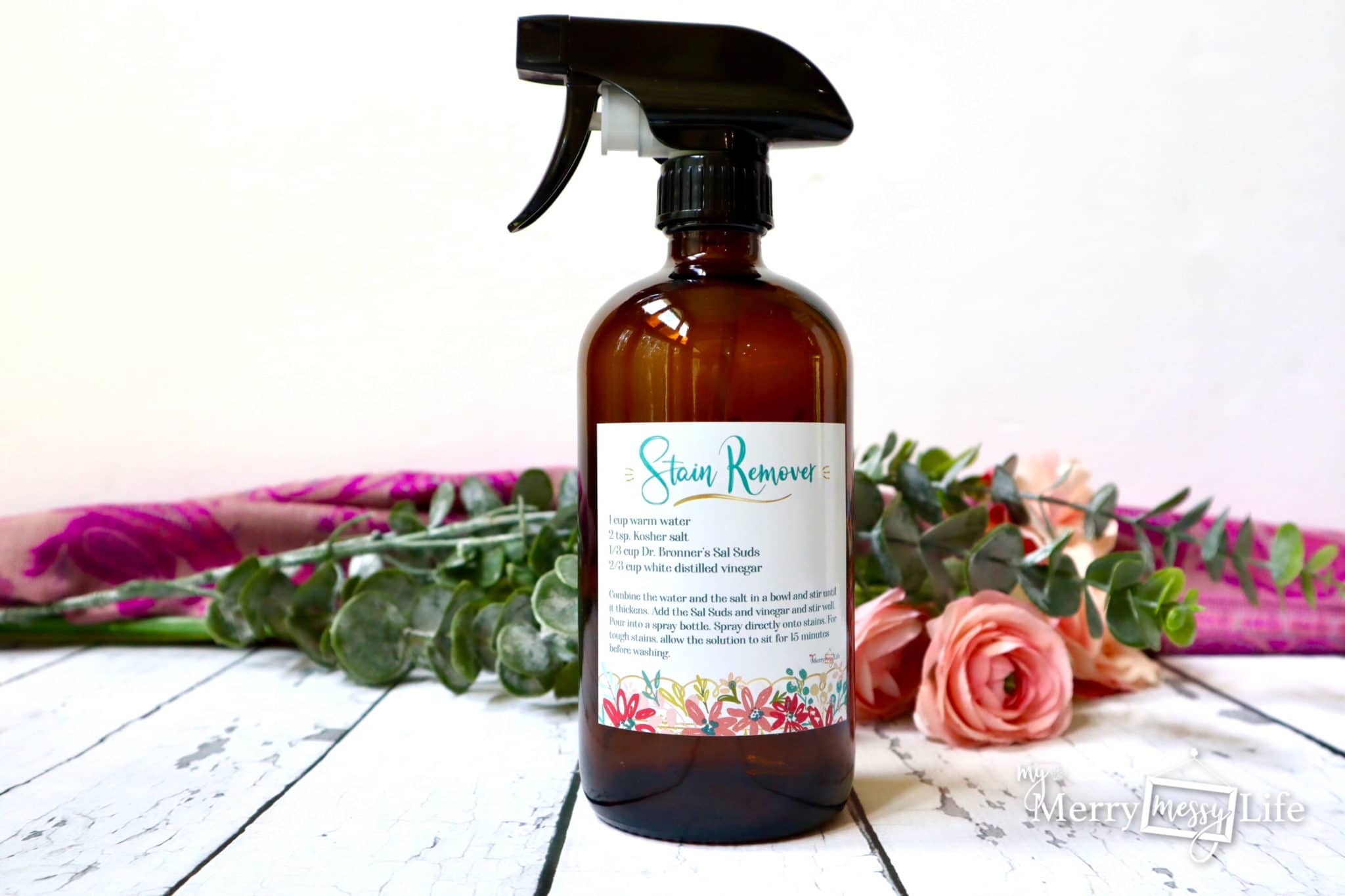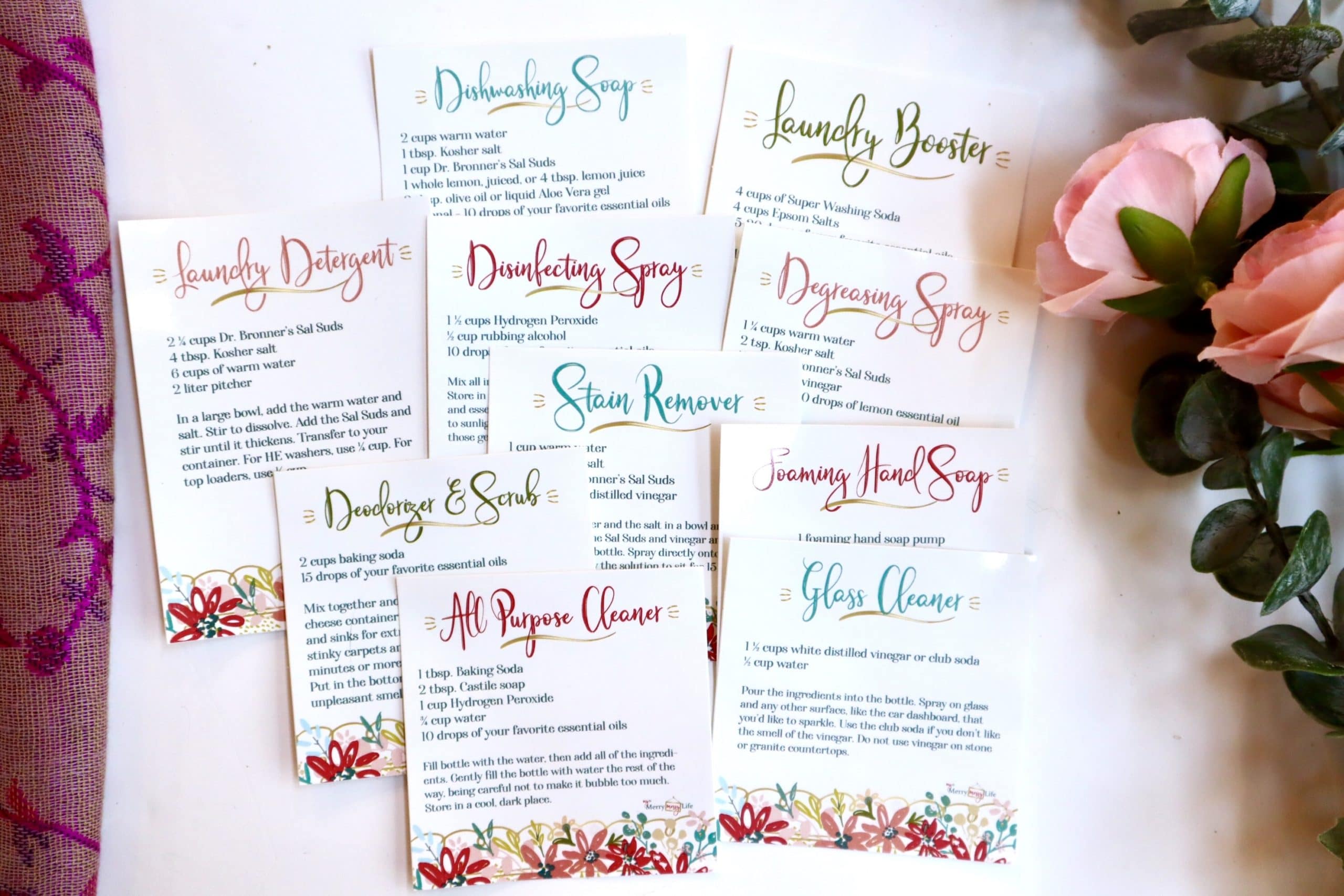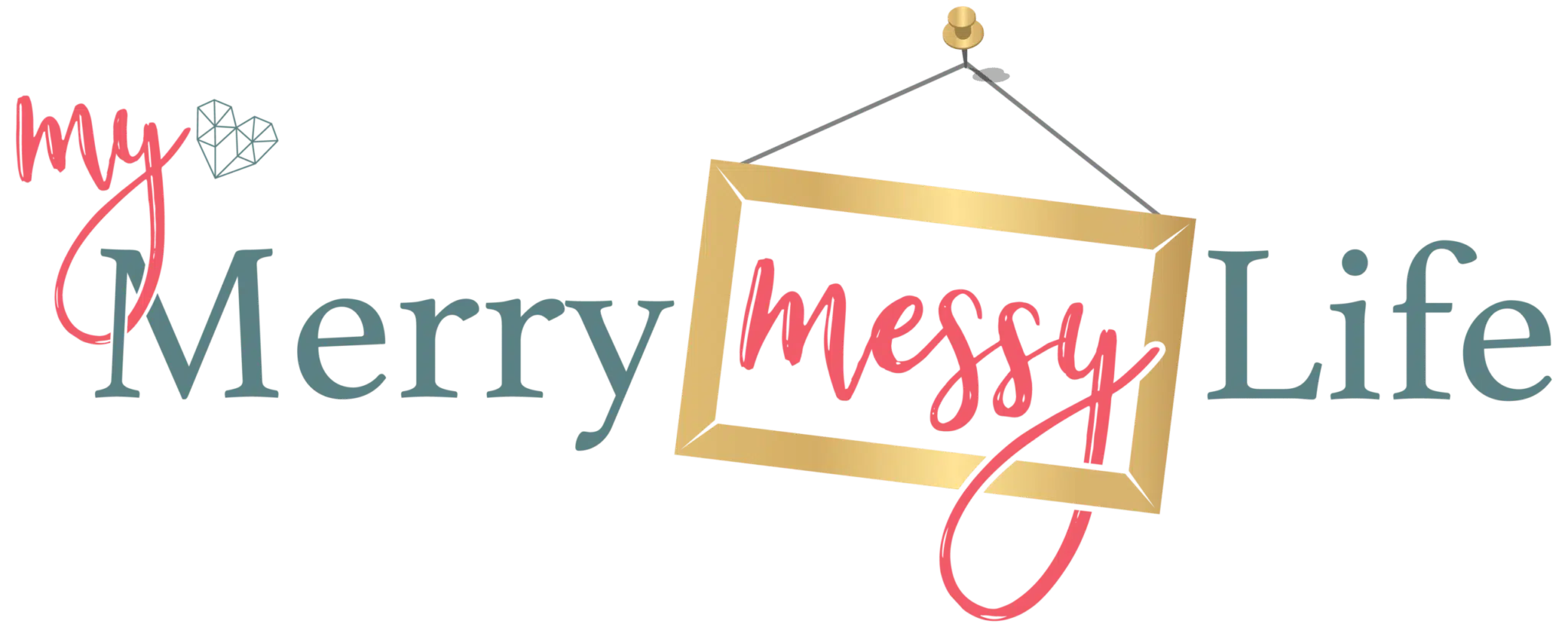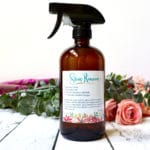Make This Easy Natural Fabric Stain Remover Recipe
A quick tutorial for an easy natural fabric stain remover recipe for laundry care that is safe, nontoxic, hypoallergenic and effective!

My Laundry Room has Gone All Natural
I've been wanting to make a non-toxic stain remover for a while, and just finally got around to it! This will join my non-toxic and gentle laundry detergent and natural fabric softener that I've been using for over a year and half. I've been noticing that when I used my go-to fabric stain remover on the clothes (OxiClean), it would have the artificial fragrance comes with the chemicals, especially since I use no artificial ingredients in my homemade laundry detergent.
Plus, it just started to be too expensive – about $7.98 for a 21.5 ounce bottle and it didn't even work all that well unless applied immediately after something fun (like dirt, poop, markers, paint, chocolate, spaghetti sauce…you get the idea) gets on the clothes.
Top 10 Cleaning and Laundry Recipes
This recipe is part of a 10-part series of natural cleaning and laundry recipes. You can find a list of all of the recipes here. This natural fabric stain remover recipe is also found in my book, Detox Your Home, which you can find on Amazon. It includes more than 80+ recipes, research and lists for natural products you can purchase all to help you go natural in your home!
Toxins in Stain Removers
I know some of you will want to know why you'd want to make your own natural fabric stain remover recipe to begin with, so here are a few reasons!
Artificial Fragrances
I’ve written about the dangers of artificial fragrances many times here on the blog! Artificial fragrances can trigger asthma attacks, worsen allergies, and cause inflammation in the sinuses that can lead to more frequent colds and respiratory infections. That’s why I prefer to scent my homemade products with essential oils (read more about them below).
Fake fragrances disperse particles of formaldehyde and phthalates (thy-lates) into the air. Phthalates are small particles of plastic that are used to bind the artificial fragrance molecules together. We then breathe in those tiny particles of plastic and they get into our nose and lungs – yuck!
1,4-Dioxane
1,4-Dioxane is a contaminant found in products that create suds. It's not an added ingredient, but is created when common ingredients, like Sodium Laureth Sulfate and PEG compounds, react with one another. It is found in many, many cleaning, laundry, and cosmetic products but you'll not find it listed on the label because it is not an added ingredient.
It is linked to cancer, digestive system effects, respiratory effects, skin irritation/allergies/damage, and damage to vision (source 1 and 2). It is considered a probably human carcinogen by the U.S. Environmental Protection Agency (EPA). It is banned for use in cosmetics in Canada.
Benefits of this Natural Stain Remover Recipe:
- Biodegradable
- Safe for the environment (many stain removers are toxic to aquatic life)
- Hypoallergenic – no artificial fragrances or irritating detergents and ingredients
- Nontoxic – safe for humans and animals
Learn About the Ingredients in This Recipe
Essential Oils
Essential oils are wonderful to use in cleaners. They add extra cleaning and germ fighting power, and also smell wonderful, making the cleaning experience more enjoyable! In my family, we also use them for our health. I only use Young Living Essential Oils as I’ve found them to be the best and most effective ones on the market. They have starter kits that make using oils for your health easier to learn about and have success with! Learn more about their oils here.
In this recipe, make sure to use an essential oil or blend that is clear in color. Anything with a color to it (like orange or Blue Tansy) WILL stain your laundry that same color. Also, I love to use lemon in cleaning and laundry because not only does it have a lovely, fresh citrus aroma, but it also helps to lift off stuck-on particles, which is especially helpful in this recipe.
Dr. Bronner’s Sal Suds
In the natural world, we have vilified Sodium Laureth Sulfate. We say it’s a carcinogen and highly toxic to aquatic life. In most cases, this is true. But did you know that not all SLS is created equal? It depends on how it’s processed.
Check out Dr. Bronner’s Sal Suds rating on the EWG.org – it gets a perfect score! Totally nontoxic and safe.
According to this article,
Sodium Lauryl Sulfate (SLS) is a surfactant that cuts grease and dirt, generates copious suds, and biodegrades quickly and completely. SLS is made by combining a sulfate group with lauryl alcohol from coconut oil, then attaching sodium. If improperly formulated, SLS can irritate skin, but our superb formula uses coco-betaine and lauryl glucoside to counter this.
Also note that SLS is not a body care product. I would not use it in my homemade body washes or hand soaps unless you’re actually washing car grease or motor oil off of your hands! And definitely don’t use it in your hair – most shampoos in the stores contain SLS, and they really dry out and then damage the hair.
It is meant to clean objects – like clothes, the kitchen, bathrooms, cars, etc.
If you're not able to get Dr. Bronner's Sal Suds, then I suggest using any natural dish soap you're able to find in your area.
White Distilled Vinegar
Vinegar is completely safe and a very effective window, all purpose cleaner, and sanitizer. But, we all know vinegar kinda stinks. So you can make some citrus infused vinegar (see my tutorial on that here) to lessen the scent, add your choice of lovely smelling essential oils to it, or do one of the other two recipes I’ve added here.
In order for it to properly sanitize, leave on the surface for 30 minutes.
DIY Natural Fabric Stain Remover Recipe
A very easy and effective natural fabric stain remover recipe – nontoxic, biodegradable, hypoallergenic and safe.
Ingredients
- 1 cup warm water
- 2 tsp. Kosher Salt
- 1/3 cup Dr. Bronner's Sal Suds
- 2/3 cup White Distilled Vinegar
- Waterproof, vinyl recipe label (so you don't have to look up the recipe again!) or my printable set of laundry labels
- 16 oz. brown amber glass spray bottle
- OPTIONAL – 10–15 drops of Lemon, Tea Tree, Pine, or Lavender (lemon is best since it help to remove stuck-on particles)
Instructions
Combine the water and the salt in a bowl and stir until it thickens (the kosher salt is essential for the thickening process). Add the Sal Suds and vinegar and stir well. Pour into a spray bottle. Spray directly onto stains. For tough stains, allow the solution to sit for 15 minutes or longer before washing.
Notes
When something gets on your laundry, rinse it out with water as soon as you can. If that's not possible, then rinse out when it is. Then, spray the stain remover on the spot(s) as soon as you can (immediately is best) and rub in with your fingers. Let it sit for 10-30 minutes to an hour. Natural solutions DO work, but they take more patience and time to do the same job a harsher cleaner does.
You can also use this recipe on carpets and upholstery. Use a Bissell SpotBot vacuum to clean after spraying (an amazing tool if you have pets or are potty training a toddler!).
Would you rather buy than make?
With our busy and full lives, making your own cleaning and laundry products isn't always possible – I totally get it! Making your own certainly is cheaper, but sometimes buying healthy products saves your time and sanity, and those are super valuable things (especially as a mom) as well! Here are some brands I recommend purchasing, that get a A grade on the EWG.org:
(Click on the links to purchase from Amazon)
- ATTITUDE Citrus Zest Laundry Stain Remover
- Earth Friendly Products Stain and Odor Remover
- Fit Organic Laundry Stain Remover & Carpet Spot Cleaner
- Sun & Earth On the Spot Remover
- BuggyLove Organic Stain Remover
Get a Waterproof, Vinyl Label from my Etsy shop
You can get a beautiful recipe label for your natural stain remover spray bottle! I designed and then had recipe labels professionally printed to make our lives easier! When you go to refill the bottle or jar, you don't have to look up the recipe again. It's printed on the label itself! These are waterproof, vinyl stickers that are high quality and do not pucker or come off even if they get wet.
- Get just the Natural Stain Remover Spray label here (waterproof, professionally printed)
- Get a set of 10 cleaning and laundry sticker labels here (as shown in the picture)



I love watching your videos want to make my own house hold detergents
I’m going to give them a try and for the recipes